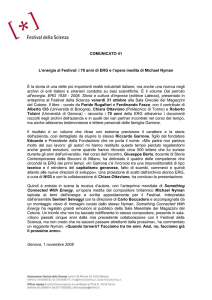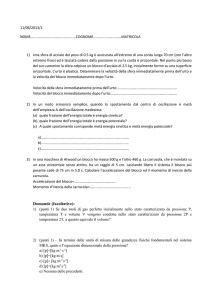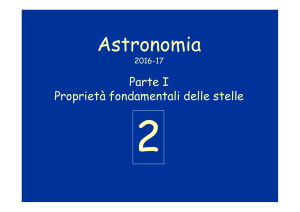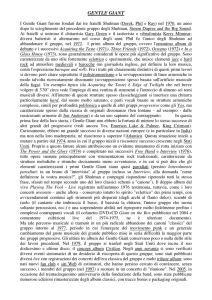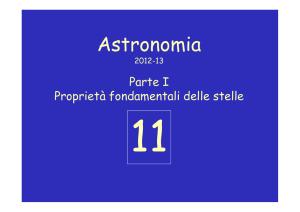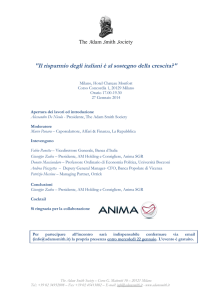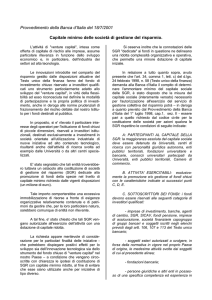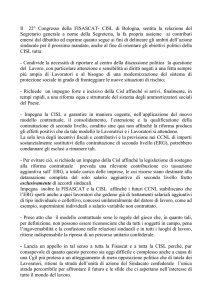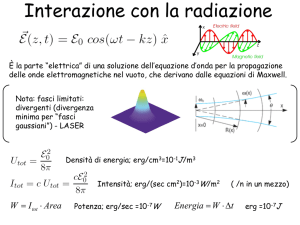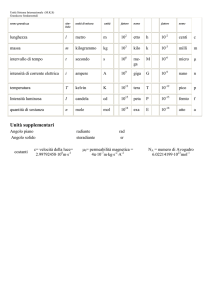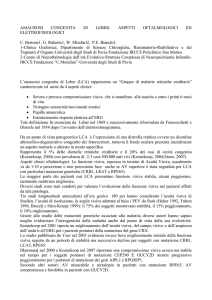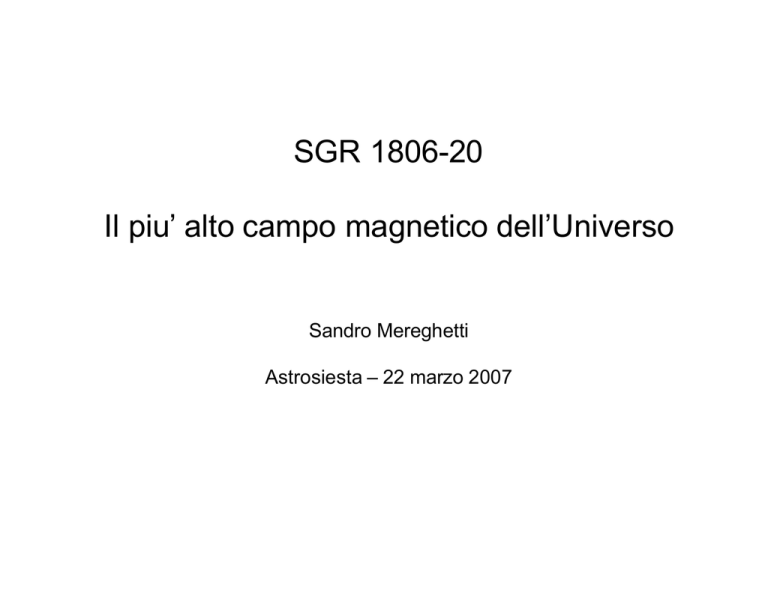
SGR 1806-20
Il piu’ alto campo magnetico dell’Universo
Sandro Mereghetti
Astrosiesta – 22 marzo 2007
26 Dicembre 2004 alle ~00:59 UTC:
Terremoto nell’Oceano Indiano e tsunami in Indonesia
E ~ 1025 erg
SID = Sudden Ionosphere Disturbance
alle ~21:30 del 27 Dicembre 2004
Sulle pagine web di IBAS dieci minuti dopo…
http://ibas.iasf-milano.inaf.it/
Jurek’s plot
7.56 s periodicity
“signature” of
SGR 1806-20
7
Imager IBIS
Spectrometer SPI
Giant
Flare
INTEGRAL SPI
Anti Coincidence Shield (ACS)
(512 kg, 91 BGO blocks)
The ACS is also used as an
omni-directional GRB detector
( E > 80 keV)
Provides:
• 50 ms light curve
• No direction information
• No energy information
?
Initial giant pulse
backscattered by
the Moon
2.8 light seconds
flux from
SGR 1806-20
Moon reflection seen also in Helicon-Coronas-F data
Frederiks et al 2007, Astron. Letters 33, 1
Initial spike properties
Fluence in Moon-backscattered peak ~2x10-6 erg/cmq
at E>80 keV
à ~ 2 erg/cmq in initial peak
- duration ~ 0.2 sec
- Peak flux ~ 10 erg/cmq/s
- E ~ 4x1046 ergs
E>20 keV
(for d = 15 kpc)
4 Soft Gamma-ray Repeaters
1900+14 1806-20
1627-41
0526-66
Stelle di neutroni isolate con campi magnetici
eccezionalmente alti: 1014-1015 G (Magnetars)
• Lx ~ 1035 erg/s, P ~ 5-8 s, spin-down
• Burst hard X/gamma, 100-1000 x Eddington, t~0.1 s
• Giant Flares (solo 3 visti finora)
L’emissione deriva dalla energia magnetica
High Frequency Oscillations in Giant Flares
QPO (Quasi Periodic
Oscillations) discovered in
the tail of the Dec 27 Giant
Flare
Israel et al. 2005, ApJ 628, L53
High Frequency Oscillations in Giant Flares
• 0526-66 – 43 Hz (Barat etal.1983)
• 1806-20 – 90 Hz, ~18 Hz, ~30 Hz (Israel et al. 2005)
626 Hz (Watts & Strohmayer 2006)
• 1900+14 – 84 Hz, 28 Hz, 53 Hz, 155 Hz
(Strohmayer & Watts 2005)
• Large scale NS crust fractures trigger global seismic
oscillations (analogous to earthquakes)
• Torsional modes of NS crust à potentially important
diagnostic for NS
QPO a 625 Hz nei dati RHESSI
(Watts & Strohmayer 2006)
Le oscillazioni ad alta frequenza in SGR 1806-20
implicano delle rapide variazioni di luminosita’
che superano il limite di Cavallo-Rees:
4
m
c
∆L
2π p
<ε
∆t
3 σT
∆L/∆t QPO ~ 2 x 1043 erg s-2 >> ε 2 x 1042 erg s-2
Soluzione proposta da Vietri et al. 2007, astro-ph/0702598
A causa del campo magnetico >Bc la sezione d’urto dei
fotoni e’ ridotta di un fattore (B/Bc)2
La variabilita’ delle QPO implica:
B > 1.5 Bc (0.1/ε)1/2 ~ 6.6 x 1013 G
(a un raggio di ~30 km)
à Bsurface > 2 1015 G

